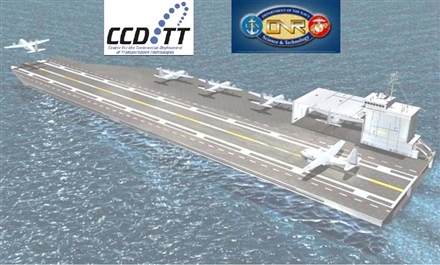September 02, 2007
Via Danger Room comes this Ares post on an innovative sea-basing concept based on a trimaran hullform. The idea is to operate C-130 sized aircraft from a carrier on a regular basis! As pointed out in the article, the US Navy operated a C-130 off of USS Forestal in the 60s but wing clearance of the island was precarious and it pretty much required all other air ops to stop.
The trimaran would allow a much wider flight deck...even given the above deck hangars contemplated for the big planes. Another aspect of the hullform is that despite the larger deck dimensions, the ship would displace a little more than half what a Nimits class carrier does. A pdf of the powerpoint is here .

With a top speed of 35 knots, faster than a lot of surface warships, the ship makes a startling contrast to the fairly slow moving (but fricking GINORMOUS) modified oil rigs that have been mooted for the mobile offshore base concept over the past decade. (more on that here and here.)
The trimaran hullform is new but has been tested by the Brits and Aussies on various mid-sized commercial vessels...though nothing this big.
The propulsion seems to be a decision between commercial off the shelf diesels ( Sulzers) and a British designed nuclear plant.
Now, I like atomic power but the narrow beam of the individual hulls would seem to provide insufficient saftey separation from the sea unless a very innovative safe reactor design is chosen. Anyone with thoughts on this please comment.
According to the pdf, they are looking at having it being buildable at several US shipyards and are designing a structurally similar vessel for the merchant marine, initially with intercostal trailer transport in mind. Both these seem very wise, both to expand our currently declining shipyard base (or at least hold it steady) and have carriers be buildable at shipyards other than Newport News.
Building the ship to commercial specifications exites me less....there is a big difference in ruggedness and I have heard on navy related forums that HMS Ocean, which was built to commercial spescifications has had problems resulting from COTS design practices. I've not heard specifics though.
Certainly something needs to be done to bring down shipbuilding costs, however, steel...even HY 130, is a lot cheaper than electronics.
This option does however lend itself to economies in maintenance and yard time as well as (possibly) faster construction and repair (if most shipyard workers are familliar with the work).
Again, anyone with actual experience in this area please chime in.
Posted by: The Brickmuppet at
07:56 AM
| Comments (6)
| Add Comment
Post contains 436 words, total size 4 kb.
Posted by: Wonderduck at Sun Sep 2 12:25:36 2007 (gwUM9)
Fleet resupply by air.
The US Navy operates one of the world's largest fleets of cargo ships. Every one of our CBT's is connected to a friendly port by a string of cargo ships going back and forth.
Even with this, there would still have to be a bit of that since you're going to need fuel. But this could carry everything else you need.
Posted by: Steven Den Beste at Sun Sep 2 13:05:40 2007 (+rSRq)
Posted by: Steven Den Beste at Sun Sep 2 13:09:38 2007 (+rSRq)
Ah. The tanker explanation makes sense. Without number-crunching that I'm not prepared (or qualified) to do, I can't comment as to whether or not it'd make sense to have something that size to act as, basically, an UNREP ship (or a dedicated tanker carrier), I could see that reasoning.
Something about it, though, feels wrong to me. A C-130 can carry a payload of 45000 pounds, according to wikipedia. A C-2 Greyhound can carry 10000 pounds, sayeth wikipedia, though that's supposedly going to be replaced by the notional Common Support Aircraft sometime in the future.
So six C-130s can carry the same amount of stuff as 27 C-2s, and that's great, but is this a cost-effective way of accomplishing the same tasks? I know there's only 39 C-2s in service, and hundreds (thousands?) of C-130s, but...
*scratching head* Someone help me out here.
Posted by: Wonderduck at Sun Sep 2 19:51:47 2007 (Hrqgp)
C-130 range: 2000 nautical miles
C-2 range: 1300 nautical miles
A different way to put it: the C-130 can loiter longer in the air.
Posted by: Steven Den Beste at Sun Sep 2 22:09:55 2007 (+rSRq)
Put it another way: a C-130 can only support the fleet if one of these ships is around. The C-2 or CSA will be available whereever there's a carrier. Or are they suggesting one of these diesel-fired trimarans will be built for each carrier group? How much fuel will they consume while keeping the fleet supplied?
I'm sure the people who designed these things are much, MUCH better versed in their jobs than myself (they'd better be!), but am I the only one who's thinking that this is going to be a logistical nightmare for something that's supposed to make logistics for the fleet easier?
It's not the C-130s I'm objecting to; they're probably the greatest plane in our military today. It's the lengths we'd have to go to to get them out with the fleet that seem to be a smidge 'out there'.
Posted by: Wonderduck at Mon Sep 3 00:23:00 2007 (Hrqgp)
69 queries taking 0.1828 seconds, 381 records returned.
Powered by Minx 1.1.6c-pink.









